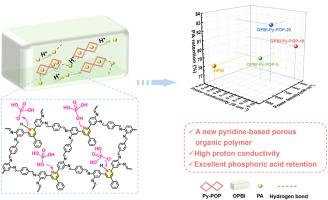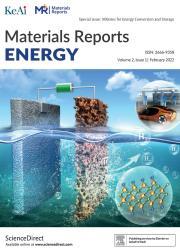A new pyridine-based porous organic polymer composited high-temperature proton exchange membrane
IF 13.8
引用次数: 0
Abstract
As promising high-temperature proton exchange membranes, phosphoric acid (PA) doped polybenzimidazole (PBI) membranes still face challenges, including excessive PA leaching and limited long-term stability. The preparation of mixed matrix membranes (MMMs) has emerged as a viable strategy to address these limitations, which can combine the excellent mechanical properties of polymers with the structural advantages of porous fillers. Among various filler materials, nitrogen-containing porous organic polymers (POPs) have shown particular promise because of their excellent compatibility with polymers. Therefore, in this work, a new pyridine-based POP called Py-POP was synthesized. Py-POP was mixed with commercial poly[2,2′-(p-oxidiphenylene)-5,5′-benzimidazole] (OPBI) to prepare MMMs. Theoretical calculations indicate that the pyridine groups exhibit strong interactions with PA, significantly enhancing both PA retention and proton conduction efficiency. Remarkably, the PA retention rate of the composite membrane doped with 10 wt% Py-POP is 77.2% at 80 °C/40% RH, which is much higher than that of the OPBI (62.7%). Furthermore, the membrane achieves an outstanding proton conductivity of 0.173 S cm−1 at 180 °C, which is 4.2 times higher than that of the OPBI membrane. The peak power density of the composite membrane can achieve 915.1 mW cm−2 and remains at 891.5 mW cm−2 after 80 cycles of testing at 180 °C.

一种新型吡啶基多孔有机聚合物复合高温质子交换膜
磷酸(PA)掺杂聚苯并咪唑(PBI)膜作为一种很有前景的高温质子交换膜,仍然面临着PA浸出过多和长期稳定性有限的挑战。混合基质膜(MMMs)的制备已经成为解决这些限制的可行策略,它可以将聚合物的优异机械性能与多孔填料的结构优势结合起来。在各种填充材料中,含氮多孔有机聚合物(pop)因其与聚合物的良好相容性而具有特殊的应用前景。因此,本文合成了一种新的吡啶基POP - Py-POP。将Py-POP与商品聚[2,2 ' -(对氧化苯)-5,5 ' -苯并咪唑](OPBI)混合制备MMMs。理论计算表明,吡啶基团与PA具有较强的相互作用,显著提高了PA的保留率和质子传导效率。值得注意的是,在80°C/40% RH下,掺10 wt% Py-POP的复合膜的PA保留率为77.2%,远高于OPBI的62.7%。此外,该膜在180°C时的质子电导率为0.173 S cm−1,是OPBI膜的4.2倍。复合膜的峰值功率密度可达915.1 mW cm−2,在180℃下经过80次循环测试后仍保持在891.5 mW cm−2。
本文章由计算机程序翻译,如有差异,请以英文原文为准。
求助全文
约1分钟内获得全文
求助全文
来源期刊

材料导报:能源(英文)
Renewable Energy, Sustainability and the Environment, Nanotechnology
CiteScore
13.00
自引率
0.00%
发文量
0
审稿时长
50 days
 求助内容:
求助内容: 应助结果提醒方式:
应助结果提醒方式:


